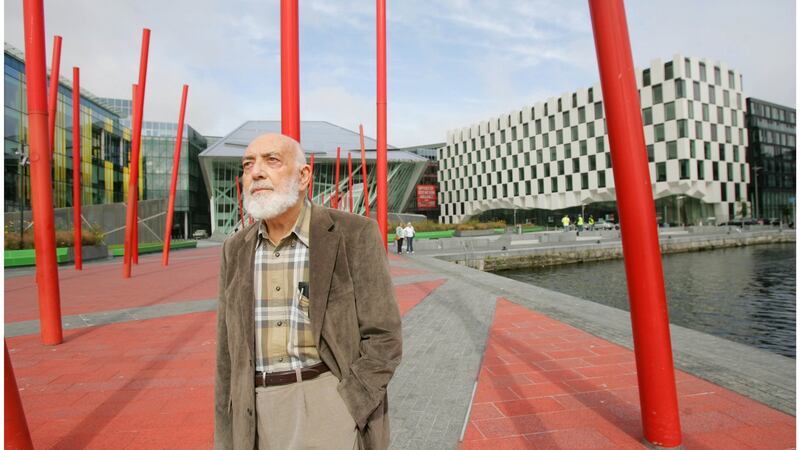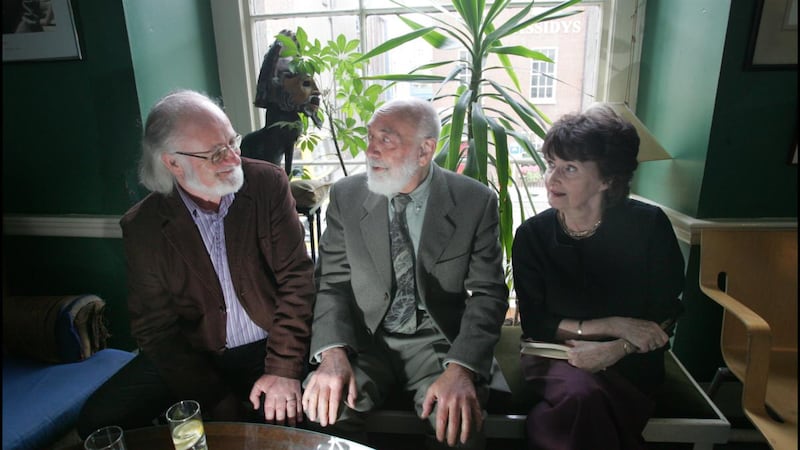When the poets Thomas Kinsella and Eavan Boland died – Boland in April 2020 and Kinsella last December – Irish poetry lost two of its most distinctive Dublin voices. Each belongs in a special way to a city that is central in their work, one that became a repository of personal memory for both writers, and therefore an essential backdrop.
Alongside their personal bonds to a common city, these two poets also share certain characteristics of attitude and temperament. Both can be considered outsiders, fiercely independent and provocative poets of disaffection who altered the agenda in Irish poetry and reshaped its map. Kinsella once admitted to a feeling of isolation from his fellow Irish poets, and Boland in her poems and essays never disguised a similar sense of being in the margins.
For each of them identity and its slippery complexities became a key subject: Kinsella suggesting that every individual writer has to make an “imaginative grasp at identity”; and Boland resorting to the “fictions of my purpose”, to assert her own identity in an overwhelmingly patriarchal literary tradition. While neither in any way became a confessional poet both produced a large body of informative autobiographical poems, often drawn from pages of the family album.
Stylistically both moved from the formal architecture of early poems to a much plainer but powerfully direct and unadorned idiom. Details of personal significance are recalled in vivid and often straightforward factual detail.
It was a job. I was seventeen.
I set the clock and caught the bus at eight
and leaned my head against the misty windows. (Boland, Unheroic)
Morning sunlight – a patch of clear memory –
warmed the path and the crumbling brick wall
and stirred the weeds sprouting in the mortar. (Kinsella, Irwin Street)
Both were responsible for a redefinition of the Irish poem, producing versions of it that challenged us to reflect on the failings and betrayals in Irish society as it evolved in the post-independence republic. The most notable example of this is Kinsella’s meditative long poem, Nightwalker, in which he targets those he regarded as having allowed commerce to overthrow the vision and ideals of the revolutionary founding generation:
A trenchcoat playground for a gombeen jungle.
In the later One Fond Embrace he speaks out against those responsible for the destruction of the city’s Viking heritage on Wood Quay, excoriating “our city fathers” for “laying flat an enduring monument to themselves”. In Night Conference, Wood Quay: 6 June 1979, (Kinsella was among the artists who took part in the on-site protests) those city fathers became “white-cuffed marauders”.
From the outset Boland set out to rectify what she saw as the exclusion of the female presence and experience in the Irish poem, and from elsewhere in Irish public life, as the abundance of male-dominated statuary, close to her alma mater Trinity College, reminded her as she walked through her father’s City of Shadows:
And the old parliament at College Green.
And the bronze arms and attitudes of orators
from Grattan to O’Connell. All Gone.

City monuments and public iconography are equally emblematic in Kinsella: in The Pen Shop he finds himself “under the eyes of Burke and Goldsmith” and then observes Larkin with “his iron arms on high”. What these two poets share most in their work, apart from the use of Dublin settings, is use of the poem as an act of indictment – in Boland’s case on behalf of those left “outside history” and in Kinsella’s it is provoked by the disappointments of post-Independence realities.
It is no coincidence that each was in the position to create out of their life’s work books dedicated solely to poems of the city: Kinsella naming his A Dublin Documentary and Boland giving hers the title A Poet’s Dublin. In one of her illuminating essays in Object Lessons she tells us that Dublin “seemed made for poetry”. For Kinsella the city gave “many important things their first shape and content”, a point he made receiving his Freedom of the City when he also recalled learning “to look at the world through the rich reality of the inner city – a living history, with shades of Swift and Emmet in my neighbourhood”.
While the tone of many of their poems is one of ire, these are also poets of compassion: in Kinsella’s case it surfaces in one of the most powerful and tender elegies by any Irish poet, Dick King, about the poet’s childhood neighbour forced from his “salt seaboard” through economic decline in rural Ireland to find work in inner-city Dublin and who in the poem is facing the end of his days in urban anonymity. In Boland’s poetry it often takes the form of empathy with the exile and the bearer of emigrant grief, so beautifully expressed in her compelling lament for those put out “the back, of our houses, of our minds”.
The empathetic side of Kinsella’s voice is even more clearly explicit in the homage to his father, The Messenger. Kinsella senior, a labourer in the Guinness brewery, is here depicted as a man worn down by conflict with his employers over a “pittance” taken from his pension. Kinsella’s political view of life, inherited from his socialist father, is the subtext of this evocative account of one man’s life. It is only one of many his poems in which the effect on him of his working-class childhood and surroundings in Dublin 8 is evident as a fertile influence vital to his artistic achievements. The exploration of the father-son relationship in The Messenger and other Kinsella poems is matched by Boland’s equally powerful – and affectionate – portrayals of mother-daughter relationships.

While their social backgrounds were entirely different and might seem to set them apart, there are common threads: family history and the nation’s history intertwine, and one equals the other in terms of the analytic discourse that runs through their work. Kinsella experienced an immersive Dublin upbringing, remaining rooted in his origins as he remapped the totality of a childhood in Inchicore and life with his grandparents around the James Street area. Boland after spending many of her young formative years away from Ireland, returned in her late teens, a homecoming she described as like being “dropped into a story with no chapter headings”. In the subsequent quest to find personal co-ordinates for herself in the city of her birth and learning to know her country, she became particularly alert to the traces of its colonial past and this was to become a ground note in the work.
Both acknowledge that their native city is divided into several versions of itself, several smaller Dublins. Boland’s shifts from the “old, torn and traded city” that provided her younger self with certain experiences and insights, the one she refers to as being “dear to us and particular” (“The Huguenot Graveyard at the Heart of the City”), to the suburban fringes where she established home, hearth and family and heard “the noise of a new Ireland”. It was there that she elevated homemaking and motherhood – as well as the neighbourhood of Dundrum – into memorable poetry.
Kinsella too found his “second roots” but moved inwardly to do so, close to the Grand Canal where he discovered a “new vista of the city”. A different Dublin entered his imaginative space giving us many of his poems “from centre city”. Boland’s engagement with Dublin remained to the last: in one of her final poems she returns to a bygone city to recall the lamplighter who was “a small / law-maker re-drawing street / corners and neighbourhoods / in our city”. While Joyce is clearly an influence on Kinsella, according to Boland she thought of him as “a writer who had lent extraordinary dignity to the city”. It is part of the legacy of these two Dublin poets that they too have dignified “corners and neighbourhoods” of their beloved city.
Pillars of a City: Celebrating poets Eavan Boland & Thomas Kinsella, an evening of readings, music and discussion on the work of the two poets will take place as part of this year’s Dublin International Literature Festival in Merrion Square Park on Sunday, May 29th, at 7pm. The full festival programme is here












